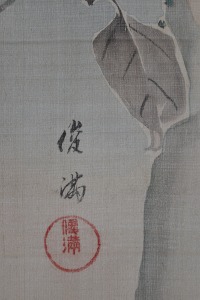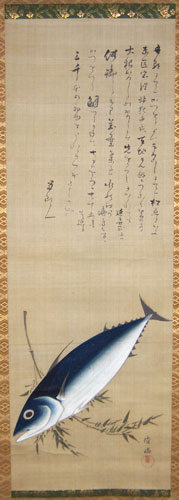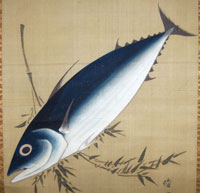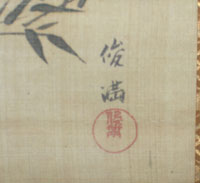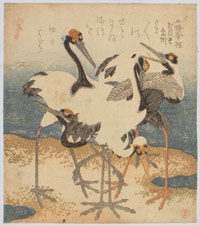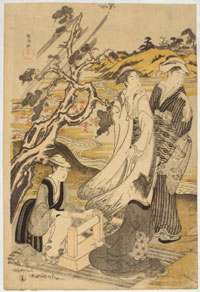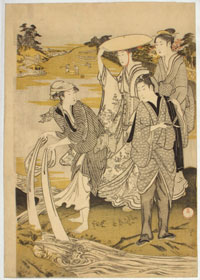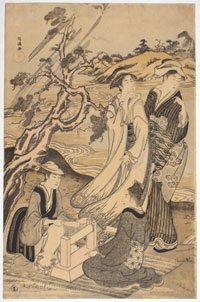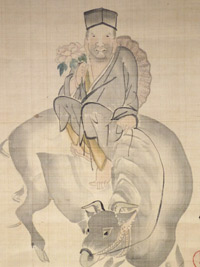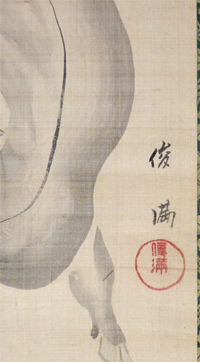Kubo SHUNMAN (1757-1820)
Click here to view image full size.
An original painting showing a sparrow taunting a horned owl. Shunman, a man of great sophistication, produced few prints (indeed, as Jack Hillier pointed out [The Japanese Print: A New Approach, pp. 102-104]: “Probably no artist except Choki has achieved so high a reputation on such a small number of prints.”); but is known for his fine surimono. Also excelled at writing, light verse, book illustration and painting of mainly bijin, making the subject matter here rare for him. However, the subject was also used for a surimono by him showing an owl on a flowering magnolia branch. Sumi and the characteristically light and subtle use of colour on silk, 36 x 11.5 in; 91.5 x 29.2 cms. Inscription above by Rosanjin. In very good condition having been remounted. Signed and sealed Shunman.
Status: Sold
Kubo SHUNMAN (1757-1820)

Click here to view image full size.
An original painting, sumi and colour on silk, 37 x 13 in; 94 x 33 cms. Shows a parading courtesan wearing a kimono of subdued colouring, being painted in sumi hues. She provocatively raises the hem of her monochromatic dress to reveal a bright red under-garment. Shunman, a man of great sophistication, designed only a few prints before concentrating on surimono and printing and issuing some of the finest in this format. (See The Japanese Print: A New Approach, J. Hillier, pp. 102-104 where he says “Probably no artist except Choki has achieved so high a reputation on such a small number of prints.”) He also excelled at painting, book illustration and light verse. Above is a poem by Ota Nampo (Shokuzanjin), a famous poet and fiction writer (1749-1823), as well as an occasional painter. In very good condition, signed and sealed Shunman.
Status: Sold
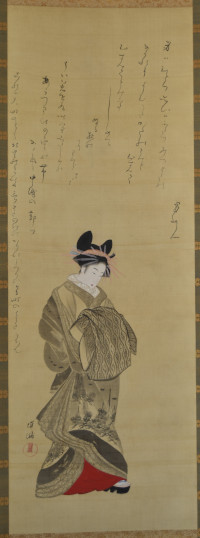
Click here to view image full size.
Kubo SHUNMAN (1757-1820)
Click here to view image full size.
An original painting of a bonito and a branch of bamboo. The bonito, called katsuo in Japan, was also called ocean bonito, strip-bellied bonito and striped tuna. It was, and is, highly regarded in Japan where it is smoked and dried to make katsuobushi, an important ingredient in making dashi ( Japanese fish stock ). The first bonito of the year were always highly anticipated. Shunman – an artist of great refinement – is famous for his exquisite surimono. Sumi and colour on silk with mica added to the eye and belly. Minor creasing and loss of gofun, otherwise good condition. Mounted with box. 90 x 31 cms; 35.5 x 12.25 inches ( image size ). Signed and sealed Shunman.
Status: Sold
Kubo SHUNMAN (1757-1820)
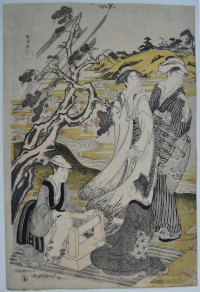
Click here to view image full size.
Mishima, or Toi, Province of Settsu. The best desigm from an exquisite set of six prints showing graceful young women, girls and, in two instances, young men representing the Six Crystal (Tama) Rivers. These streams were noted for the purity of their water. The prints are in benigirai style, “red avoiding,” a technique pioneered by Shunman, Eishi and Shuncho. Shows a seated girl fulling cloth (hence Toi which is the alternative name of the river and the word for beating cloth) with three other beauties near the village of Mishima. A light shower passes by in the background. Shunman, a man of great sophistication, designed only a few prints before concentrating on surimono and printing and issuing some of the finest in this format. (See The Japanese Print: A New Approach, J. Hillier, pp. 102-104 where he says “Probably no artist except Choki has achieved so high a reputation on such a small number of prints.”) He also excelled at painting, book illustration and light verse. Published by Fushimiya Zenroku, c 1787. (A later edition was published by Tsutaya with less harmonious colours.) One of the most beautiful 18th century sets, and together with a night triptych showing people returning from a poetry reading, is considered his masterpiece. The complete set (trimmed) is illustrated in the Gale Catalogue Of Japanese Paintings & Prints, J. Hillier, Routledge, 1970, number 133 (a) – (f). Provenance: Originally purchased from me in 2008. Rare.
Fine impression. The centre female’s kimono blind-printed. Very good colour: printed only in tones of grey, light yellow and light pink, with touches of light red on the tree. Very small repaired wormhole, otherwise extremely good condition with extra paper at left. Probably untrimmed (whereas illustrated examples all seem to be trimmed somewhere). Signed Shunman with seal Shunman.
Status: Sold
Kubo SHUNMAN (1757-1820)
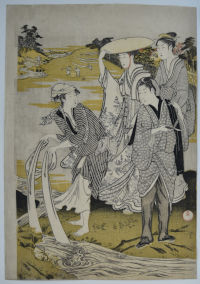
Click here to view image full size.
Chobu, Province of Musashi from an exquisite set of six prints showing graceful young women, girls and, in two instances, young men representing the Six Crystal (Tama) Rivers. These streams were noted for the purity of their water. The prints are in benigirai style, “red avoiding,” a technique pioneered by Shunman, Eishi and Shuncho.Shows a girl washing stripes of cloth in the stream. In fact, this design conjoins with the previous print in the set of six prints. Shunman, a man of great sophistication, designed only a few prints before concentrating on surimono and printing and issuing some of the finest in this format. (See The Japanese Print: A New Approach, J. Hillier, pp. 102-104 where he says “Probably no artist except Choki has achieved so high a reputation on such a small number of prints.”) He also excelled at painting, book illustration and light verse. Published by Fushimiya Zenroku, c 1787. (A later edition was published by Tsutaya with less harmonious colours.) One of the most beautiful 18th century sets, and together with a night triptych showing people returning from a poetry reading, is considered his masterpiece. The complete set (trimmed) is illustrated in the Gale Catalogue Of Japanese Paintings & Prints, J. Hillier, Routledge, 1970, number 133 (a) – (f). Provenance: Originally purchased from me in 2008. Rare.
Fine impression with some blind-printing. Very good colour: printed only in tones of grey, light yellow and light pink, with touches of light red on the tree. Very small repaired wormhole, otherwise extremely good condition with extra paper at left. Probably untrimmed (whereas illustrated examples all seem to be trimmed somewhere). Signed Shunman with seal Shunman.
Status: Sold
Kubo SHUNMAN (1757 – 1820)
Click here to view image full size.
A superb surimono showing a group of five cranes on a split of sand. The tancho ( “red crest” ) Japanese Crane, Grus japonensis, is the second rarest crane in the world, migrating to East Asia in the fall to spend the winter. There is also a resident flock in Hokkaido. Much loved by the Japanese, the crane was a symbol of luck, longevity and fidelity.One of a set of six surimono with title: San hira no uchi, “Three Petals” written on a poem slip hanging from a plum branch, top left. Probably Shunman’s masterpiece in this format and one of the handful of great surimono. Exceptionally rare: I have not seen another for sale since I started dealing over 40 years ago and this may well be the only available impression extant. An example is in the Chester Beatty Library, Dublin. See The Art of Surimono, Roger Keyes, Sothebys, 1985, no. 318, p. 363 and colour, p. 344. Another is in the Tokyo National Museum, catalogue II, no. 1654. There are two states with the last character of poem changed. ( For an example of this other state see Surimono, Charlotte van Rappard-Boon, no. 16, p. 33. ) Issued 1816. Shunman, a man of great sophistication, designed only a few prints before concentrating on surimono and printing and issuing some of the finest in this format. ( See The Japanese Print A New Approach, J. Hillier, pp. 102 – 104: “Probably no artist except Choki has achieved so high a reputation on such a small number of prints.” ) He also excelled at painting, book illustration and light verse.
Very fine impression with the feathers of the cranes deeply gauffraged. Fine colour with gold and silver. Minor marks and creases. Seal Shunman lower right corner.
Status: Sold
Kubo SHUNMAN (1757-1820)
Click here to view image full size.
A rare surimono showing new year festivities before a large screen depicting Mount Fuji at sunset. A versatile and highly talented artist working in various mediums, Shunman produced (and cut and printed) some of the finest surimono. Published c 1810s. I cannot, at the moment, locate another impression.
Fine impression and colour with extensive gold and silver. Fine condition. Sealed Shunman bottom right.
Fine impression and colour with silver and gold. Light backing, otherwise very good condition. Signed Shokyuko Shuntei ga.
Status: Sold
Kubo SHUNMAN (1757–1820)
Click here to view image full size.
Mishima, or Toi, Province of Settsu. The best design from an exquisite set of six prints showing graceful young women, girls and, in two instances, young men representing the Six Crystal ( Tama ) Rivers. These streams were noted for the purity of their water. The prints are in benigirai style, “red avoiding”, a technique pioneered by Shunman, Eishi and Shuncho. Shows a seated girl fulling cloth ( hence Toi which is the alternative name of the river and the word for beating cloth ) with three other beauties near the village of Mishima. A light shower passes by in the background. Shunman, a man of great sophistication, designed only a few prints before concentrating on surimono and printing and issuing some of the finest in this format. ( See The Japanese Print A New Approach, J. Hillier, pp. 102 – 104: “Probably no artist except Choki has achieved so high a reputation on such a small number of prints.” ) He also excelled at painting, book illustration and light verse. Published by Fushimiya Zenroku, c 1787. ( A later edition was issued by Tsutaya with less harmonious colours. ) One of the most beautiful 18th century sets, and together with a night triptych showing people returning from a poetry reading, is considered his masterpiece. Rare.
Fine impression. The centre female’s kimono blind-printed. Very good colour: printed only in tones of grey, light yellow and light pink, with touches of light red on the tree’s leaves. Very small repaired wormhole, otherwise extremely good condition with extra paper at left. Probably untrimmed ( whereas illustrated examples all seem to be trimmed somewhere ). Signed Shunman with seal Shunman.
Status: Sold
Kubo SHUNMAN (1757–1820)
Click here to view image full size.
Chobu, Province of Musashi from an exquisite set of six prints showing graceful young women, girls and, in two instances, young men representing the Six Crystal ( Tama ) Rivers. These streams were noted for the purity of their water. The prints are in benigirai style, “red avoiding”, a technique pioneered by Shunman, Eishi and Shuncho. Shows a girl washing stripes of cloth in the stream. In fact, this design conjoins with the following in the set of six prints. Shunman, a man of great sophistication, designed only a few prints before concentrating on surimono and printing and issuing some of the finest in this format. ( See The Japanese Print A New Approach, J. Hillier, pp. 102 – 104: “Probably no artist except Choki has achieved so high a reputation on such a small number of prints.” ) He also excelled at painting, book illustration and light verse. Published by Fushimiya Zenroku, c 1787. ( A later edition was issued by Tsutaya with less harmonious colours. ) One of the most beautiful 18th century sets, and together with a night triptych showing people returning from a poetry reading, is considered his masterpiece. Rare.
Fine impression with some blind printing. Very good colour: printed only in tones of grey, light yellow and light pink, with touches of light red on the tree’s leaves. Very small repaired wormhole, otherwise extremely good condition with extra paper at left. Probably untrimmed ( whereas illustrated examples all seem to be trimmed somewhere ). Signed Shunman with Shunman seal.
Status: Sold
Kubo SHUNMAN (1757-1820)
Click here to view image full size.
Mishima, or Toi, Province of Settsu. The best design from an exquisite set of six prints showing gracefull young women, girls and, in two instances, young men representing the Six Crystal ( Tama ) Rivers. These streams were noted for the purity of their water. The prints are in benigirai style, “red avoiding”, a technique pioneered by Shunman, Eishi and Shuncho. Shows a seated girl fulling cloth ( hence Toi which is the alternative name of the river and the word for beating cloth ) with three other beauties near the village of Mishima. A light shower passes by in the background. Shunman, a man of great sophistication, designed only a few prints before concentrating on surimono and printing and issuing some of the finest in this format. ( See The Japanese Print A New Approach, J. Hillier, pp. 102 – 104: “Probably no artist except Choki has achieved so high a reputation on such a small number of prints.” ) He also excelled at painting, book illustration and light verse. Published by Fushimiya Zenroku, c 1787. ( A later edition was issued by Tsutaya with less harmonious colours. ) One of the most beautiful 18th century sets, and together with a night triptych showing people returning from a poetry reading, is considered his masterpiece. Rare.
Fine impression. The centre female’s kimono blind-printed. Very good colour: printed only in tones of grey, light yellow and light pink, with touches of light red on the tree’s leaves. Minor marks, otherwise very good condition. Probably untrimmed ( whereas illustrated examples all seem to be trimmed somewhere ). Signed Shunman with Shunman seal.
Status: Sold
Kubo SHUMMAN (1757-1820)
Click here to view image full size.
A fine painter and renowned for his surimono, and for supervising the design and carving of them for fellow poets. Produced some refined prints and contributed to kyoka anthologies. Changed the character with which he wrote “Shun” of Shunman from”Spring” to “Excel” in 1782. Shows a Botangesyohaku ( poet ) holding a peony and riding an ox. The kyoka poem above is by Ota Nampo ( 1749-1823 ), a leading light of popular literature who often collaborated with Shumman. Sumi and light colour on silk. 36 x 12 in; 91.5 x 30.5 cms. Old mount and box. In very good condition. Signed and sealed Shumman.
Status: Sold
Artists
( A to Z )
Kyogado ASHIKUNI ( Fl. c. 1807 – 1818 )
Gigado ASHIYUKI ( Fl. c. 1814 – 1833 )
Ki BAITEI ( 1734 – 1810 )
Takizawa BAKIN ( 1767 – 1848 )
Ono BAKUFU ( 1888 – 1976 )
Georges BIGOT ( 1860 – 1927 )
Kawamura BUMPO ( 1779 – 1821 )
Ippitsusai BUNCHO ( Fl. c. 1765 – 1792 )
Toyohara CHIKANOBU ( 1838 – 1912 )
Kishi CHIKUDO ( 1826 – 1897 )
Tsubaki CHINZAN ( 1801 – 1854 )
Eishosai CHOKI ( Fl. c. 1756 – 1808 ). See also SHIKO
Rekisentei EIRI ( Fl. c. 1790 – 1800 )
Keisai EISEN ( 1790 – 1848 )
Hosoda EISHI ( 1756 – 1829 )
Hosoda EISHO ( Fl. c. 1780 – 1800 )
Ichirakutei EISUI ( Fl. c. 1790 – 1823 )
Kikugawa EIZAN ( 1787 – 1867 )
Hirano HAKUHO ( 1879 – 1957 )
Elizabeth KEITH ( 1887 – 1956 )
Imao KEINEN ( 1845 – 1924 )
Yashima GAKUTEI ( 1786 – 1868 )
Ogata GEKKO ( 1859 – 1920 )
Adachi GINKO ( Fl. c. 1847 – 1897 )
Matsumura GOSHUN ( 1752 – 1811 )
GYOSAI. See Kawanabe KYOSAI
Hirano HAKUHO ( 1879 – 1957 )
Suzuki HARUNOBU ( 1724 – 1770 )
Kawase HASUI ( 1883 – 1957 )
Kitagawa HIDEMARO ( Fl. c. early 19th century )
Kinoshita HIRONOBU ( Fl. c. 1851 – 1870 )
Gosotei HIROSADA ( Fl. c. 1847 – 1863 )
Ichiryusai HIROSHIGE ( 1797 – 1858 )
Ichiryusai HIROSHIGE II ( 1826 – 1869 )
Ando HIROSHIGE III ( 1843 – 1894 )
Nakamura HOCHU ( Fl. c. late 18th to early 19th century )
Sakai HOITSU ( 1761 – 1828 )
Totoya HOKKEI ( 1780 – 1850 )
Teisai HOKUBA ( 1771 – 1844 )
Shunkosai HOKUEI (Active 1824-1837)
Katsushika HOKUGA ( Fl. c. 1830 )
Shotei HOKUJU ( Fl. c. 1789 – 1818 )
Katsushika HOKUSAI ( 1760 – 1849 ). Also used numerous other names such as: SORI, SHUNRO, SHINSAI
Shokosai HOKUSHU ( Fl. c. 1808 – 1832 )
KEISAI. See Kitao MASAYOSHI
Suzuki KIITSU ( 1796 – 1858 )
Kitagawa KIKUMARO ( Fl. c. ? – 1830 ). See TSUKIMARO
Kobayashi KIYOCHIKA ( 1847 – 1915 )
Torii KIYOHIRO ( Fl. c. 1737 – 1771 )
Torii KIYOMASA ( Fl. c. 1700 – 1722 )
KIYOMINE. See Torii KIYOMITSU II
Torii KIYOMITSU ( 1735 – 1785 )
Torii KIYOMITSU II ( 1787 – 1868 ). See KIYOMINE
Torii KIYONAGA ( 1752 – 1815 )
Torii KIYONOBU ( 1664 – 1729 )
Torii KIYONOBU II ( 1706 – 1763 )
Torii KIYOTSUNE ( Fl. c. 1757 – 1779 )
Isoda KORYUSAI ( Fl. c. 1767 – 1788 )
Ohara KOSON ( 1877 – 1945 ). See SHOSON
Torii KOTONDO ( 1900 – 1976 )
Toyohara KUNICHIKA ( 1835 – 1900 )
Utagawa KUNIHIRO ( Fl. c. 1815 – 1843 )
Ichiunsai KUNIHISA ( 1832 – 1891 )
Utagawa KUNINAO ( 1793 – 1854 )
Utagawa KUNISADA ( 1786 – 1865 )
Utagawa KUNISADA II ( 1823 – 1880 )
Utagawa KUNISATO ( ? – 1858 )
Utagawa KUNITERU ( 1808 – 1876 )
KUNITERU. See Utagawa SADASHIGE
Utagawa KUNITERU II ( 1829 – 1874 )
Utagawa KUNIYASU ( 1794 – 1832 )
Ichiyusai KUNIYOSHI ( 1797 – 1861 )
Santo KYODEN. See Kitao MASANOBU
Kawanabe KYOSAI ( 1831 – 1889 ). See GYOSAI
Okumura MASANOBU ( 1686 – 1764 )
KitaoMASANOBU ( 1761 – 1816 ). See Santo KYODEN
Kitao MASAYOSHI ( 1764 – 1824 ). See KEISAI
Oishi MATORA ( 1794 – 1833 )
Hishikawa MORONOBU ( Fl. c. 1618 – 1694 )
Nishimura NANTEI ( 1775 – 1834 )
Utagawa NOBUKATSU ( Fl. c. 1830 – 1844 )
Watanabe NOBUKAZU ( Fl. c. late 19th century )
Hishikawa RYUKOKU ( Fl. c. 1808 – 1816 )
Jokei RYUKOSAI ( Fl. 1772 – 1816 )
Gokitei SADAFUSA ( Fl. c. 1825 – 1850 )
Hasegawa SADAHARU ( Fl. c. 1830 – 1844 )
Gokotei SADAKAGE ( Fl. c. 1818 – 1844 )
Utagawa SADAHIDE ( 1807 – 1873 )
Hasegawa SADANOBU ( 1809 – 1879 )
Utagawa SADASHIGE ( Fl. c. mid 19th century ). See KUNITERU
Gofutei SADATORA ( Fl. c. 1825 )
Yamaguchi SHIGEHARU ( 1803 – 1853 )
Kitao SHIGEMASA ( 1739 – 1820 )
Nishimura SHIGENAGA ( 1697 ? – 1756 )
Nishimura SHIGENOBU ( Fl. c. 1724 – 1735 )
SHIKO. See Eishosai CHOKI
Ryuryukyo SHINSAI ( 1764 – 1820 )
Ito SHINSUI ( 1898 – 1972 )
Kojima SHOGETSU ( Fl. c. 1880 – 1890 )
SHOSON. See Ohara KOSON
Takahashi SHOTEI ( 1871 – 1945 )
Yamamoto SHOUN ( 1870 – 1965 )
Yamakawa SHUHO ( 1898 – 1944 )
Katsukawa SHUNCHO ( Fl. c. 1780 – 1795 )
Takehara SHUNCHOSAI ( Fl. c. 1772 – 1801 )
Katsukawa SHUN’EI ( 1762 – 1819 )
Katsukawa SHUNKO ( 1743 – 1812 )
Hishikawa SHUNKYO ( Fl. c. early 19th century )
Kubo SHUNMAN ( 1757 – 1820 )
Katsukawa SHUNSEN ( Fl. c. 1762 – 1830 )
Natori SHUNSEN ( 1886 – 1960 )
Gatoken SHUNSHI ( Fl. c. 1820 – 1828 )
Katsukawa SHUNSHO ( 1726 – 1792 )
Katsukawa SHUNTEI ( 1770 – 1820 )
Katsukawa SHUNZAN ( Fl. c. 1782 – 1798 )
Yamaguchi SOKEN ( 1759 – 1834 )
Ikeno TAIGA ( 1723 – 1776 )
Katsukawa TERUSHIGE ( Fl. c. 1715 – 1725 )
Mori TETSUZAN (1775-1841)
Migita TOSHIHIDE ( 1863 – 1925 )
Mizuno TOSHIKATA ( 1866 – 1908 )
Okumura TOSHINOBU ( Fl. c. 1717 – 1750 )
Utagawa TOYOHARU ( 1735 – 1814 )
Utagawa TOYOHIRO ( 1773 – 1828 )
Utagawa TOYOKUNI ( 1769 – 1825 )
Utagawa TOYOKUNI II ( 1777 – 1835 ). See TOYOSHIGE
Yamamura TOYONARI ( 1885 – 1942 )
Ishikawa TOYONOBU ( 1711 – 1785 )
TOYOSHIGE. See Utagawa TOYOKUNI II
TSUKIMARO. See Kitagawa KIKUMARO
Kitano TSUNETOMI ( 1880 – 1947 )
Toyokawa UMEKUNI ( Fl. c. 1816 – 1826 )
Kitagawa UTAMARO ( 1753 – 1806 )
Kitagawa UTAMARO II ( ? – 1831 )
Inoue YASUJI ( 1864 – 1889 )
Hiroshi YOSHIDA ( 1876 – 1950 )
Ipposai YOSHIFUJI ( 1828 – 1887 )
Utagawa YOSHIIKU ( 1833 – 1904 )
Utagawa YOSHIKATA ( Fl. c. 1841 – 1864 )
Utagawa YOSHIKAZU ( Fl. c. 1850 – 1870 )
Toyokawa YOSHIKUNI ( Fl. c. 1803 – 1840 )
Utagawa YOSHIMUNE ( 1817 – 1880 )
Ichiyosai YOSHITAKI ( 1841 – 1899 )
Utagawa YOSHITORA ( Fl. c. 1850 – 1880 )
Taiso YOSHITOSHI ( 1839 – 1892 )
Utagawa YOSHITSURU ( Fl. c. 1840 – 1850 )
Ichieisai YOSHITSUYA ( 1822 – 1866 )
Mori YOSHIYUKI ( 1835 – 1879 )
Shibata ZESHIN ( 1807 – 1891 )


